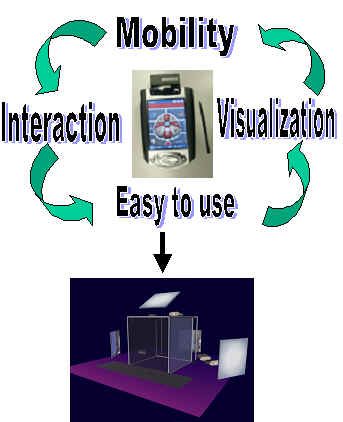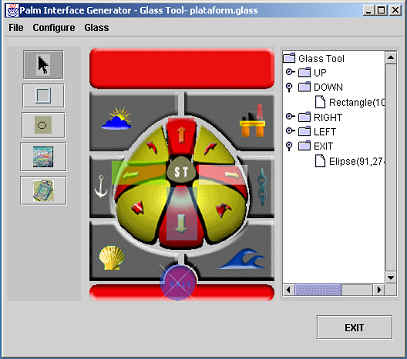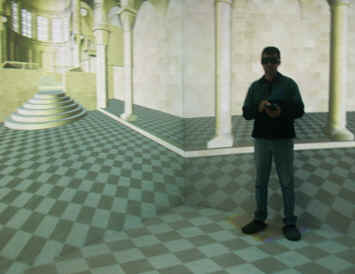 Download - Presentation
Download - Presentation Download - Presentation
Download - Presentation
There is an increasing need for innovative and effective approaches and techniques for product development that can meet the needs of today’s competitive markets.Companies must increase the products with quality and low cost, which improves the product competitiveness.
The MobileControl opens up many opportunities for the products competitiveness. It allows you use a PDA to control any devices that are connected on the network.
It enables you to envision your products and processes in ways that provides the necessary foresight to make the right decision at right time. It can fit on many situations.
At office
- Visualizing your airplane project
At home
- Playing games
At lab
- Visualizing molecules
The MobileControl explores the possibilities of controlling any device easily, such as CAVEs and Power Walls. A Java application running in the mobile system communicates transparently with the remote system, via any underlying network system. The user's input are processed on the remote system, and possibly returns new data to the display. Very little bandwidth is required.
The MobileControl solution offers:
Mobility
Easy programming
Easy to use
Cost-effective
High performance
High interactivite
Glass library
The MobileControl is a Glass application. Glass is a library for distributed computing, It was designed to fulfill a number of requirements:
• Extensibility and flexibility: the library must the easy to extend, without requiring API changes or even recompilation. This way, it will be always up-to-date with the latest technologies and be able to solve specific needs of users.
• Portable and interoperable: distributed computing is everyday more heterogeneous. The library must not only run in different architectures and operating systems, but interoperate among them
• Easy to use, fast learning curve: distributed APIs tend to be complicated, requiring a lot of time to understand and master. Most libraries provide a huge number of functions, many of them with a high number of arguments. It’s hard to learn and remember
• High performance: if an application requires distributed computing, it’s because it has a high computational cost. Glass must be as light as possible
• Network protocol independent: an abstraction of the underlying network protocol makes Glass protocol independent. You can use TCP, UDP, or even more high level systems such as MPI easily. Just instantiate the proper network class. This is very important in a world where applications have hugely different network requirements
• Reliable and fault tolerant: any distributed computing library must be reliable and fault tolerant. It’s unacceptable that the failure of a node will bring down the entire computational system. Glass had to provide fault tolerance automatically, and be reliable to make sure that faults would be as rare as possible
• Completely thread safe: many APIs are note thread safe. This forces the user to find workarounds or use other solutions in place of threads. Glass had to work in thread applications seamlessly.
Interface Generator
The PDA interface is generated by a glass tool automaticaly. A simple GUI editor allows anybody with a minimal knowledge of computers to create a GU (figure 2)I: no programming knowledge of any kind is required, everything is done in an intuitive, graphical way.


The model was supplied by Makro Dabrovic (mdabrov@rna.hr)
Laboratory of Integrable Systems - Polytechnic School - University of São Paulo
Av. Prof. Luciano Gualberto, 158 – Travessa 3 – Butantã
CEP: 05508-900 - São Paulo - SP - Brazil
Tel: (+55 11) 3818-5254 – Fax: (+55 11) 3818-5665
- Supervisor
Marcelo Knorich Zuffo mkzuffo@lsi.usp.br
- Developers
Marcelo de Paiva Guimarães paiva@lsi.usp.br
Bruno Barberi Gnecco brunobg@lsi.usp.br